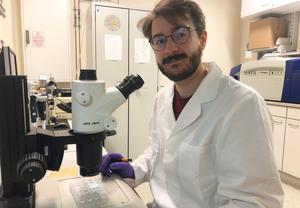First author Dr. Rabe von Pappenheim examines protein crystals of a bacterial enzyme that was "poisoned" with an antivitamin. Courtesy of Lisa-Marie Funk
Researchers at the University of Göttingen and the Max Planck Institute for Biophysical Chemistry Göttingen have now described a promising new approach involving "antivitamins" to develop new classes of antibiotics. The results were published in the journal Nature Chemical Biology.
Antivitamins are substances that inhibit the biological function of a genuine vitamin. Some antivitamins have a similar chemical structure to those of the actual vitamin whose action they block or restrict. For this study, professor Kai Tittmann's team from the Göttingen Center for Molecular Biosciences at the University of Göttingen worked together with professor Bert de Groot's group from the Max Planck Institute for Biophysical Chemistry Göttingen and professor Tadgh Begley from Texas A&M University.
Together, they investigated the mechanism of action at the atomic level of a naturally occurring antivitamin of vitamin B1. Some bacteria are able to produce a toxic form of this vital vitamin B1 to kill competing bacteria. This particular antivitamin has only a single atom in addition to the natural vitamin in a seemingly unimportant place and the exciting research question was why the action of the vitamin was still prevented or "poisoned".
Tittmann's team used high-resolution protein crystallography to investigate how the antivitamin inhibits an important protein from the central metabolism of bacteria. The researchers found that the "dance of the proton,s" which can normally be observed in functioning proteins, almost completely ceases to function and the protein no longer works.
"Just one extra atom in the antivitamin acts like a grain of sand in a complex gear system by blocking its finely tuned mechanics," explains Tittmann.
It is interesting to note that human proteins are able to cope relatively well with the antivitamin and continue working. de Groot and his team used computer simulations to find out why this is so.
"The human proteins either do not bind to the antivitamin at all or in such a way that they are not 'poisoned'," he says. The difference between the effects of the antivitamin on bacteria and on human proteins opens up the possibility of using it as an antibiotic in the future and thus creating new therapeutic alternatives.
The research project was funded by the German Research Foundation (DFG).
Reference: F. Rabe von Pappenheim et al. Structural basis for antibiotic action of the B1 antivitamin 2?-methoxy-thiamine. Nature Chemical Biology (2020). https://doi.org/10.1038/s41589-020-0628-4
Source: University of Göttingen

Great article, just what I wanted to find.
Hello would you mind letting me know which hosting company you’re utilizing? I’ve loaded your blog in 3 completely different web browsers and I must say this blog loads a lot quicker then most. Can you suggest a good web hosting provider at a reasonable price? Thanks a lot, I appreciate it!
My brother suggested I might like this website. He was totally right. This post actually made my day. You cann’t imagine just how much time I had spent for this information! Thanks!
I have been surfing online more than three hours lately, yet I never found any interesting article like yours. It’s pretty worth enough for me. Personally, if all website owners and bloggers made good content as you did, the net might be much more useful than ever before.
Highly energetic blog, I liked that a lot. Will there be a part 2?
Usually I do not read article on blogs, however I wish to say that this write-up very pressured me to try and do so! Your writing taste has been amazed me. Thank you, quite great article.
Thank you for some other great article. Where else may anyone get that kind of information in such a perfect means of writing? I have a presentation next week, and I am at the look for such information.
You’ve made some good points there. I looked on the web to find out more about the issue and found most individuals will go along with your views on this website.
Hello very nice website!! Guy .. Beautiful .. Amazing .. I will bookmark your website and take the feeds also? I am glad to seek out numerous useful information here in the publish, we’d like develop more strategies in this regard, thank you for sharing. . . . . .